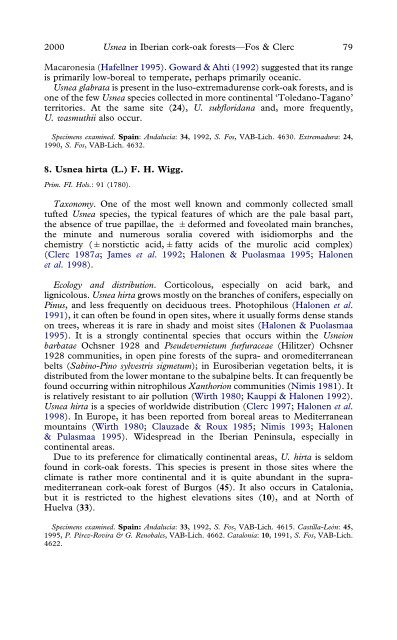the lichen genus usnea on quercus suber in iberian cork-oak forests
the lichen genus usnea on quercus suber in iberian cork-oak forests
the lichen genus usnea on quercus suber in iberian cork-oak forests
You also want an ePaper? Increase the reach of your titles
YUMPU automatically turns print PDFs into web optimized ePapers that Google loves.
2000 Usnea <strong>in</strong> Iberian <strong>cork</strong>-<strong>oak</strong> <strong>forests</strong>—Fos & Clerc 79<br />
Macar<strong>on</strong>esia (Hafellner 1995). Goward & Ahti (1992) suggested that its range<br />
is primarily low-boreal to temperate, perhaps primarily oceanic.<br />
Usnea glabrata is present <strong>in</strong> <str<strong>on</strong>g>the</str<strong>on</strong>g> luso-extremadurense <strong>cork</strong>-<strong>oak</strong> <strong>forests</strong>, and is<br />
<strong>on</strong>e of <str<strong>on</strong>g>the</str<strong>on</strong>g> few Usnea species collected <strong>in</strong> more c<strong>on</strong>t<strong>in</strong>ental ‘Toledano-Tagano’<br />
territories. At <str<strong>on</strong>g>the</str<strong>on</strong>g> same site (24), U. subfloridana and, more frequently,<br />
U. wasmuthii also occur.<br />
Specimens exam<strong>in</strong>ed. Spa<strong>in</strong>: Andalucía: 34, 1992, S. Fos, VAB-Lich. 4630. Extremadura: 24,<br />
1990, S. Fos, VAB-Lich. 4632.<br />
8. Usnea hirta (L.) F. H. Wigg.<br />
Prim. FI. Hols.: 91 (1780).<br />
Tax<strong>on</strong>omy. One of <str<strong>on</strong>g>the</str<strong>on</strong>g> most well known and comm<strong>on</strong>ly collected small<br />
tufted Usnea species, <str<strong>on</strong>g>the</str<strong>on</strong>g> typical features of which are <str<strong>on</strong>g>the</str<strong>on</strong>g> pale basal part,<br />
<str<strong>on</strong>g>the</str<strong>on</strong>g> absence of true papillae, <str<strong>on</strong>g>the</str<strong>on</strong>g> deformed and foveolated ma<strong>in</strong> branches,<br />
<str<strong>on</strong>g>the</str<strong>on</strong>g> m<strong>in</strong>ute and numerous soralia covered with isidiomorphs and <str<strong>on</strong>g>the</str<strong>on</strong>g><br />
chemistry (norstictic acid,fatty acids of <str<strong>on</strong>g>the</str<strong>on</strong>g> murolic acid complex)<br />
(Clerc 1987a; James et al. 1992; Hal<strong>on</strong>en & Puolasmaa 1995; Hal<strong>on</strong>en<br />
et al. 1998).<br />
Ecology and distributi<strong>on</strong>. Corticolous, especially <strong>on</strong> acid bark, and<br />
lignicolous. Usnea hirta grows mostly <strong>on</strong> <str<strong>on</strong>g>the</str<strong>on</strong>g> branches of c<strong>on</strong>ifers, especially <strong>on</strong><br />
P<strong>in</strong>us, and less frequently <strong>on</strong> deciduous trees. Photophilous (Hal<strong>on</strong>en et al.<br />
1991), it can often be found <strong>in</strong> open sites, where it usually forms dense stands<br />
<strong>on</strong> trees, whereas it is rare <strong>in</strong> shady and moist sites (Hal<strong>on</strong>en & Puolasmaa<br />
1995). It is a str<strong>on</strong>gly c<strong>on</strong>t<strong>in</strong>ental species that occurs with<strong>in</strong> <str<strong>on</strong>g>the</str<strong>on</strong>g> Usnei<strong>on</strong><br />
barbatae Ochsner 1928 and Pseudevernietum furfuraceae (Hilitzer) Ochsner<br />
1928 communities, <strong>in</strong> open p<strong>in</strong>e <strong>forests</strong> of <str<strong>on</strong>g>the</str<strong>on</strong>g> supra- and oromediterranean<br />
belts (Sab<strong>in</strong>o-P<strong>in</strong>o sylvestris sigmetum); <strong>in</strong> Euros<strong>iberian</strong> vegetati<strong>on</strong> belts, it is<br />
distributed from <str<strong>on</strong>g>the</str<strong>on</strong>g> lower m<strong>on</strong>tane to <str<strong>on</strong>g>the</str<strong>on</strong>g> subalp<strong>in</strong>e belts. It can frequently be<br />
found occurr<strong>in</strong>g with<strong>in</strong> nitrophilous Xanthori<strong>on</strong> communities (Nimis 1981). It<br />
is relatively resistant to air polluti<strong>on</strong> (Wirth 1980; Kauppi & Hal<strong>on</strong>en 1992).<br />
Usnea hirta is a species of worldwide distributi<strong>on</strong> (Clerc 1997; Hal<strong>on</strong>en et al.<br />
1998). In Europe, it has been reported from boreal areas to Mediterranean<br />
mounta<strong>in</strong>s (Wirth 1980; Clauzade & Roux 1985; Nimis 1993; Hal<strong>on</strong>en<br />
& Pulasmaa 1995). Widespread <strong>in</strong> <str<strong>on</strong>g>the</str<strong>on</strong>g> Iberian Pen<strong>in</strong>sula, especially <strong>in</strong><br />
c<strong>on</strong>t<strong>in</strong>ental areas.<br />
Due to its preference for climatically c<strong>on</strong>t<strong>in</strong>ental areas, U. hirta is seldom<br />
found <strong>in</strong> <strong>cork</strong>-<strong>oak</strong> <strong>forests</strong>. This species is present <strong>in</strong> those sites where <str<strong>on</strong>g>the</str<strong>on</strong>g><br />
climate is ra<str<strong>on</strong>g>the</str<strong>on</strong>g>r more c<strong>on</strong>t<strong>in</strong>ental and it is quite abundant <strong>in</strong> <str<strong>on</strong>g>the</str<strong>on</strong>g> supramediterranean<br />
<strong>cork</strong>-<strong>oak</strong> forest of Burgos (45). It also occurs <strong>in</strong> Catal<strong>on</strong>ia,<br />
but it is restricted to <str<strong>on</strong>g>the</str<strong>on</strong>g> highest elevati<strong>on</strong>s sites (10), and at North of<br />
Huelva (33).<br />
Specimens exam<strong>in</strong>ed. Spa<strong>in</strong>: Andalucía: 33, 1992, S. Fos, VAB-Lich. 4615. Castilla-León: 45,<br />
1995, P. Pérez-Rovira & G. Renobales, VAB-Lich. 4662. Catal<strong>on</strong>ia: 10, 1991, S. Fos, VAB-Lich.<br />
4622.

















